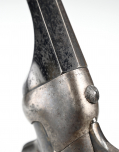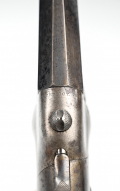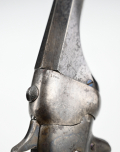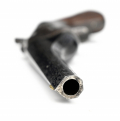site search
online catalog
CONNECTICUT ARMS AND MANUFACTURING CO. HAMMOND .44 RIMFIRE “BULLDOG” PISTOL, WITH WOOD GRIPS
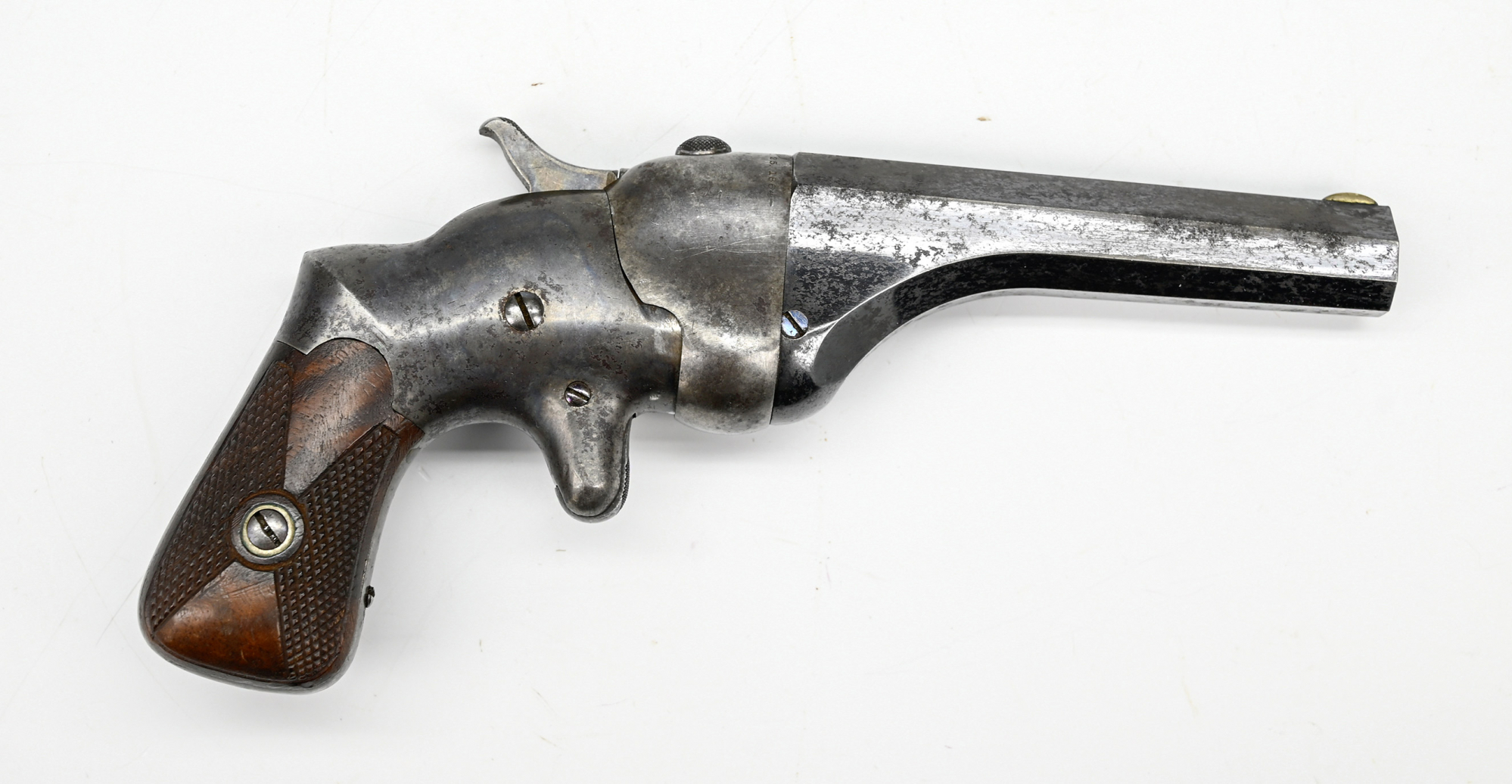
$1,050.00
Quantity Available: 1
Item Code: 490-7039
Shipping: Determined by Method & Location of buyer
To Order:
Call 717-334-0347,
Fax 717-334-5016, or E-mail
Most of the production models of the single-shot .44 caliber Hammond “Bulldog” seem to have been made with composite grips (often simply, but inaccurately referred to as gutta-percha.) This one retains wood grips, contoured and checkered like the composite grips and identically brown color, but showing their grain, etc. This rates about very good for condition, showing about 10% finish: some thin, mottled blue mixed with gray on the barrel, mostly near the breech, with the breechblock a muted silver gray with some brown spots, and the frame a thin, faded blue. The metal is smooth, and markings are sharp: “CONNECTICUT ARMS & MANF’G CO NAUBUC CONN.” on the top barrel flat and “PATENTED OCT 25. 1864.” on the forward edge of the breechblock. The screws show some good blue. Both sights are place. The checkered breedblock release button, grooved to double as the rear sight, is rubbed, but has some faint blue. (This releases the barrel to pivot left for loading.) The grips have a good fit, color, surface, and checkering, but the left panel shows a short narrow vertical crack as the bottom and a very small chip next to the buttstrap.
These pistols were elegantly styled. The 4” barrel is octagon, with the bottom flats having rounded ends giving the impression of flutes in the frame and the barrel giving the appearance of narrowing by a tapering top barrel flat that comes to a point beyond the front sight, effectively making it seven-sided at the muzzle. The receiver, however, has very round contours that transition into the flat-sided but bag-style grips (of then modern thermoplastic) with rounded butt. Those smooth lines, along with the use of a spur trigger, may also have given it some appeal to the practical-minded looking for pistol that was not obtrusive and could be smoothly drawn from a pocket, and the pistol was robust enough to handle the .44 caliber round.
Brothers Henry and Lewis Hammond tried to enter the Civil War military arms business by incorporating in mid-1863 and developing a breech-loading single-shot cartridge system. Initial rejection of their patent as being too close to other, existing patents, followed by errors in a renewed application and its processing delayed its grant until late October 1864, and attempts at a military contract for longarms were unsuccessful. They had a little more luck with this Deringer or pocket pistol, which used the same sort of swivel breach block that pivots to the left for inserting a cartridge after placing the hammer at half-cock and depressing a button on top of the block. The button is cross-hatched, but also slotted to function as a rear sight, and the block is fitted with an automatic ejector that will partially lift out the cartridge case for removal.
This is serial numbered 479, putting it pretty early in the production run and perhaps explaining the wood grips. Production estimates fall under 8,000 in total. The pistols are generally assumed to have been introduced in 1865, though the ejector and rear sight did not receive patents until mid-1866 and very early 1867 according to Tim Prince, the company may have pushed forward anyway, perhaps with the obvious October 1864 patent date deemed a sufficient warning. In any case, production was very limited in number and in duration. Henry Hammond reportedly filed some later firearms related patents, but the NRA museum notes that production ceased in 1868, due to a mortgage problem and Mike Helms notes the company assets were sold off in 1872. Many of the pistols, however, remained in dealer inventories, advertised for sale into the 1880s, which may have led some arms students to assume a longer production run.
This a nice example of a Deringer that would go well in a display of such vest and coat pocket pistols carried for personal defense in the early west. The pistol has acquired the nickname of the “Bulldog” among collectors. This may be a faulty recollection of the barrel inscription “bull dozer” found on some of these, but either nickname is a reminder of its power and danger at close range. [sr][ph:m]
DISCLAIMER: All firearms are sold as collector's items only - we do not accept responsibility as to the shooting safety or reliability of any antique firearm. All firearms are described as accurately as possible, given the restraints of a catalog listing length. We want satisfied customers & often "under" describe the weapons. Any city or state regulations regarding owning antique firearms are the responsibility of the purchaser. All firearms are "mechanically perfect" unless noted, but again, are NOT warranted as safe to fire!
~~~~~~~~~~~~~~~~~~~~~~~~~~~~~~~~~~~
THIS ITEM, AS WITH ALL OTHER ITEMS AVAILABLE ON OUR WEB SITE,
MAY BE PURCHASED THROUGH OUR LAYAWAY PROGRAM.
CLICK HERE FOR OUR POLICIES AND TERMS.
THANK YOU!
Inquire About CONNECTICUT ARMS AND MANUFACTURING CO. HAMMOND .44 RIMFIRE “BULLDOG” PISTOL, WITH WOOD GRIPS
For inquiries, please email us at [email protected]
Most Popular
Historical Firearms Stolen From The National Civil War Museum In Harrisburg, Pa »
Theft From Gravesite Of Gen. John Reynolds »
Selection Of Unframed Prints By Don Troiani »
Fine Condition Brass Infantry Bugle Insignia »
British Imported, Confederate Used Bayonet »
Scarce New Model 1865 Sharps Still In Percussion Near Factory New »
featured item
VERY RARE 1834 ENGINEER AND MEDICAL STAFF SWORD BY HENRY BOKER, BELONGING TO BREVET BRIGADIER GENERAL JOHN HENDRICKSON, WHO LOST A LEG AT FREDERICKSBURG, 83rd NEW YORK VOLS (9th NYSM) AND 13th V.R.C.
New patterns of swords for the U.S. army were developed from 1832 to 1834. This elegant smallsword pattern (variously called by collectors the 1832 or 1834 pattern) was designated for officers of Engineers and Medical Staff (and Pay Department as… (870-325). Learn More »
site search
Upcoming Events
May 16 - 18: N-SSA Spring Nationals, Fort Shenandoah, Winchester, VA Learn More »









